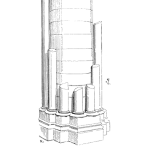
The wrong combination of metals in electrical contact create a Galvanic Corrosion Trap that will cause many failures and costs in the future
Abstract:
The Galvanic Corrosion Trap. The wrong combination of metals can produce a corrosion cell of unequal voltage where one metal gives up its electrons and corrodes away. If the corrosion is not detected it will result in eventual failure of the equipment. Galvanic corrosion prevention is a design selection issue that one must always be aware of, as it can arise with the simplest of decisions. This article highlights a galvanic corrosion problem often seen in industry and sometimes missed by the person selecting equipment.
Keywords: rusting, corrosion scale, galvanic corrosion cell
When a refrigeration unit failed after three years in service, the pipe work had to be cut to remove the old unit and install a new one. Upon inspection it was found that the bore of the carbon steel pipe was 80% blocked with corrosion scale. The blockage slowed the chilled water down so much that the refrigeration unit froze the water and the ice burst the pipes.

You can see in the image that the pipe work leading to the refrigeration unit on the right were made of copper. But the chilled water circuit pipe work, to and from the heat exchanger, was made of carbon steel.
When you have both copper and carbon steel piping in the same water circuit you create a very nice galvanic corrosion cell working against you. You can see from the galvanic series of metals in salt water, listed below, that copper and carbon steel are well apart in voltage potential. Carbon steel rapidly corrodes when copper is connected to it by either direct contact, or through an electrolytic medium like process chilled water.
Controlling Galvanic Corrosion
The best answer to the problem is also to be found in the galvanic series. You need to use metals that are very close in voltage potential so there is little inclination for one to corrode the other. If that is not possible then you may need to introduce a sacrificial material that will corrode in preference to the structural materials. Or, should that also not be possible, you will have to chemically treat the water to control the corrosion.

The Effect of Surface Areas
One other important factor in the rate of galvanic corrosion is the respective amount of surface areas of each of the metals. A large surface area ratio in the wrong direction between the metals will cause a huge corrosion rate of the vulnerable material. It will fail in unbelievably quick time!
The table below highlights the problem of rapid corrosion from severe surface area difference between some common dissimilar metals.

Galvanic corrosion is a major cause of industrial equipment failure and can be greatly reduced if the correct decisions are made at the design stage.
Dear Sir,
I have a question concerning the galvanic corrosion.
In an HVAC system, we have to connect the copper to a steel pipe, the system is a closed loop for a chilled water network.
Does this lead to a galvanic corrosion? If so, what prevention could be taken, without using a dielectric union?
Thank you in advance, Wissam
Dear Wissam,
Definitely you will get galvanic corrosion through the water. Even a dielectric union won’t save the steel from eventually corroding. Can one of the pipes be plastic – PVC, PP or PE?
Otherwise run a very short copper pipe (half a meter or a couple of feet) with a very long steel pipe (tens of meters or dozens of feet) and flange the two together with a non-metallic gasket.
Webpage http://inspectapedia.com/plumbing/Dielectric_Pipe_Fitting_Codes.php suggests you connect the two together using plastic fittings or brass fittings.
The very best to you, Mike
Leave a Reply